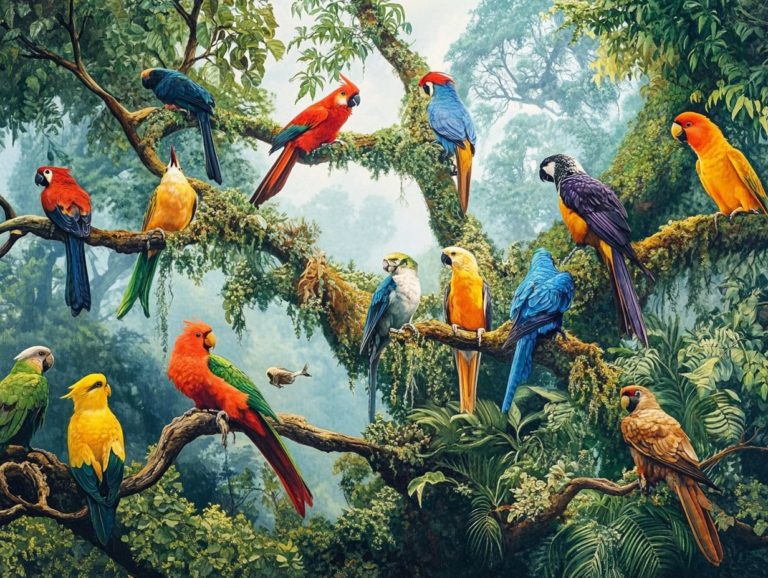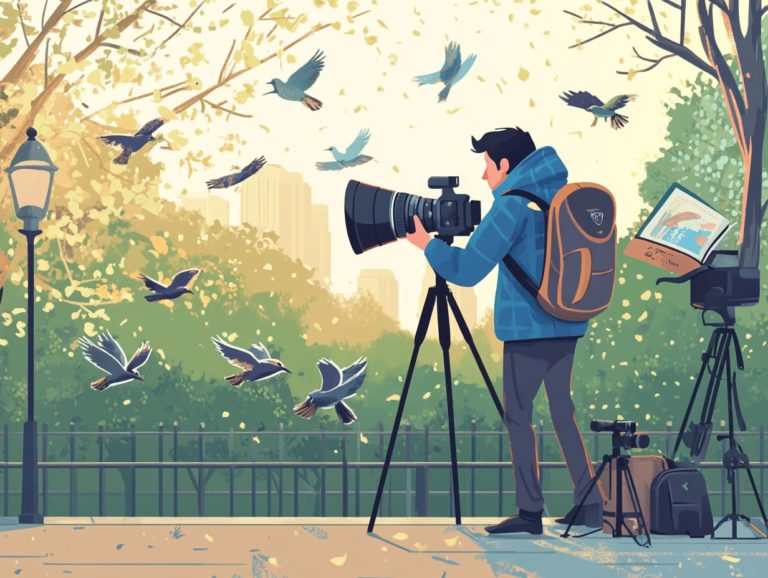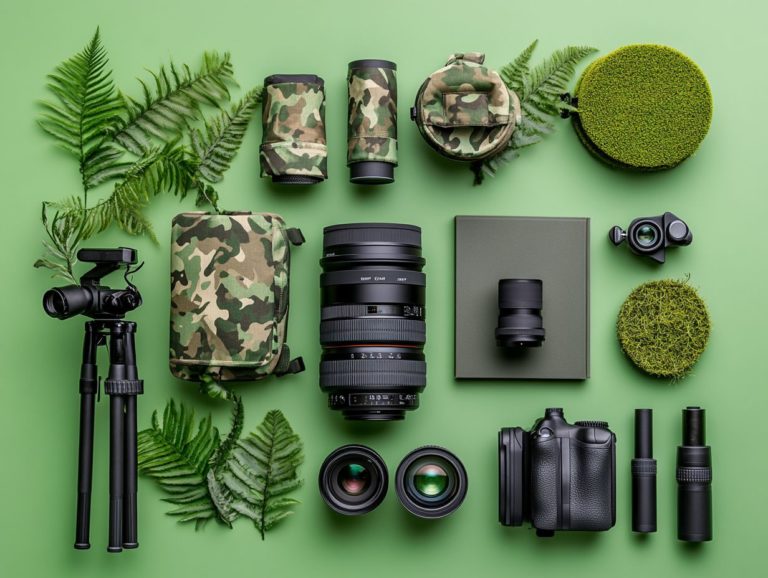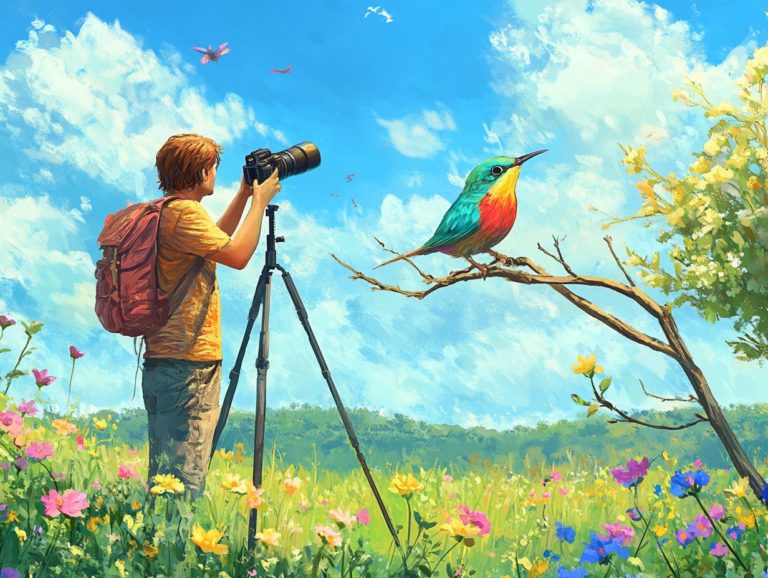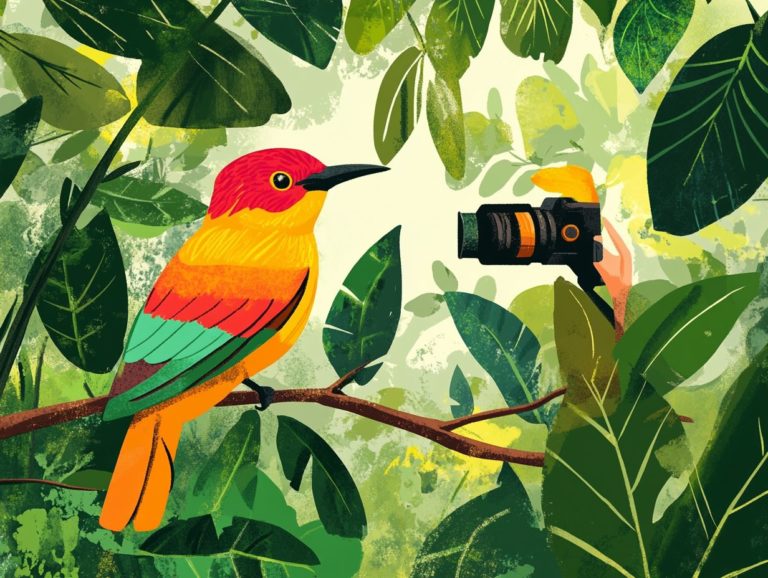Essentials for Bird Photography in Different Seasons
Get ready to dive into the vibrant world of bird photography! Bird photography provides a remarkable opportunity for you to connect with nature, allowing you to capture the beauty and behavior of these incredible creatures throughout the year.
This guide clearly explains the essential techniques and equipment tailored for each season, from the vibrant migrations of spring to the serene elegance of winter.
Whether you re photographing nesting birds, seizing the thrill of flight in summer, or navigating the unique challenges of fall and winter photography, you ll find a wealth of tips and insights designed to elevate your skills and enrich your experience.
Gear up to elevate your bird photography journey in every season!
Contents
- Key Takeaways:
- 1. Spring
- 2. Summer
- 3. Fall
- 4. Winter
- Frequently Asked Questions
- What are the essential equipment for bird photography in different seasons?
- How can I prepare for bird photography in the winter season?
- What are some tips for bird photography in the spring season?
- What are the challenges of bird photography in the summer season?
- What are some techniques for bird photography in the fall season?
- How can I find the best locations for bird photography in different seasons?
Key Takeaways:
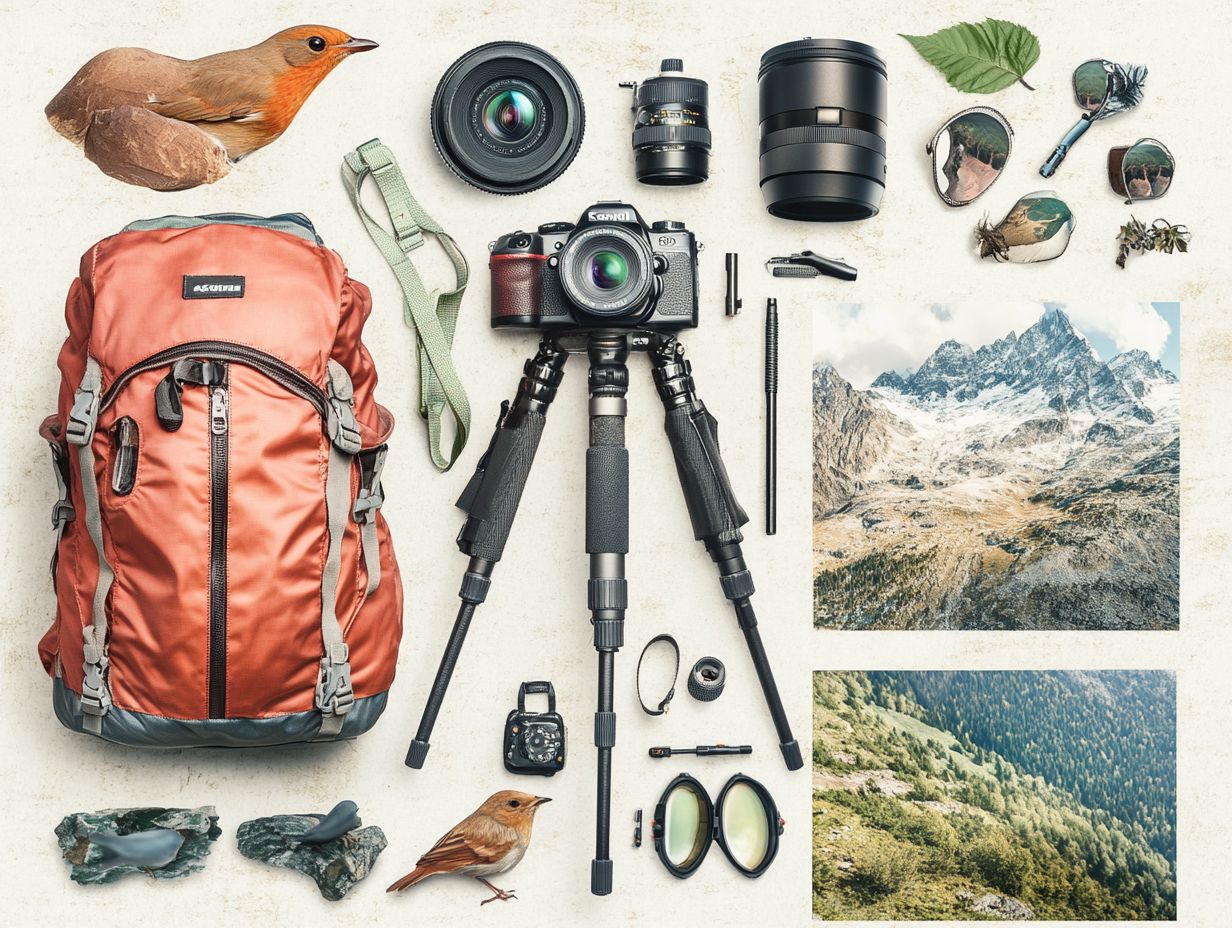
- Be prepared for the various seasons when photographing birds migration in spring, vibrant colors in autumn, and snow in winter.
- Adjust your camera settings and equipment accordingly for each season low light in winter, vibrant colors in autumn, and birds in flight in summer.
- Use specific techniques for each season capturing nesting birds in spring, migrating birds in autumn, and birds in flight during summer.
1. Spring
Spring is an exhilarating time for wildlife photographers. It’s perfect for capturing the mesmerizing migration of birds. This season lures dedicated photographers like yourself to embark on photography trips, eager to observe and document remarkable bird behavior, especially by learning how to photograph birds with different backgrounds.
Armed with top-tier camera gear like the Nikon Z9 and Canon EOS R3, you re all set to enhance your results. This time of year marks a pivotal chapter in the avian calendar, as countless species embark on their annual journeys, traveling vast distances to reach their breeding grounds.
Picture popular locations wetlands, coastal areas, and wildlife reserves coming to life with vibrant activity, offering you incredible opportunities to witness and capture stunning interactions.
To prepare for these adventures, delve into researching migration patterns and pinpoint hotspots that align with your shooting goals. Essential photography gear for you might include:
- A dependable telephoto lens, which allows you to take close-up photos from a distance, without disturbing the wildlife.
- A sturdy photo backpack to securely carry all your necessary equipment.
- The right tripod to stabilize your shots and ensure crisp images.
With the right gear in hand, you can immortalize those fleeting moments that define this breathtaking season.
How to Capture Birds During Migration Season
To effectively capture birds during migration season, you need to employ specific shooting techniques that enhance your ability to document their behavior in dynamic outdoor environments. Utilizing equipment like the Canon EOS R3, along with action cameras for unique perspectives, can elevate your photography.
Scouting locations is absolutely crucial. Migratory paths can vary significantly depending on the time of year and environmental factors, so familiarizing yourself with natural habitats and seasonal changes that attract these avian travelers will often lead to remarkable sightings.
Understanding bird behavior, including feeding and nesting patterns, can significantly boost your chances of encountering them. Practicing patience is key, allowing you to wait for those fleeting moments when birds are at their most active.
Using telephoto lenses is another essential strategy. This enables you to capture stunning close-up shots without disturbing the wildlife, preserving the integrity of their natural surroundings.
Must-Have Equipment for Spring Bird Photography
For spring bird photography, having the right equipment is essential; must-have items are a telephoto lens and a reliable photo backpack, ensuring you’re fully prepared for those spontaneous wildlife encounters.
Investing in high-quality gear, like the Nikon Z 24-120mm lens, can significantly elevate your ability to capture vibrant, detailed images from a distance. It s not just about the primary lens; keeping spare camera batteries on hand is a must. Wildlife can be unpredictable, and there s nothing more frustrating than missing the perfect shot due to battery failure.
Auxiliary gear like sturdy tripods provides the stability you need for those long shots, while comfortable camera straps can alleviate the strain during extended outings. This way, you can concentrate on your craft rather than worrying about your equipment.
Tips for Photographing Nesting Birds
Photographing nesting birds offers a rewarding yet challenging experience that invites you to embrace specific photography guidelines. This ensures you capture the essence of wildlife without disrupting the delicate behaviors of these remarkable creatures in their natural habitats.
To strike that perfect balance, it s essential to keep your distance. A telephoto lens becomes your best friend, allowing you to snap those intimate shots while respecting their space. Understanding the birds’ behaviors, like feeding and nesting patterns, can significantly enhance your shooting opportunities.
By patiently observing these routines, you can anticipate their movements and capture stunning images at just the right moment. Employing the right camera settings think fast shutter speeds and high ISO enables you to achieve clear shots without invading their personal space.
This approach enhances your photography and champions an ethical stance that prioritizes the well-being of these incredible avians. Remember to adjust your camera settings based on environmental conditions.
2. Summer
Summer offers a vibrant canvas for your wildlife photography endeavors. With longer days at your disposal, it’s the perfect time to embark on photography trips that allow you to experiment with various camera settings and techniques.
Don’t forget to take advantage of nature sounds to enhance your experience. The warm weather and lush landscapes improve your visibility, making it significantly easier to spot and photograph animals during their most active hours.
Early mornings and late afternoons, particularly during the golden hour when the sun casts a warm, soft glow, present exceptional conditions for striking images. You can fine-tune settings like ISO and shutter speed to adapt to the changing light.
This ensures your shots remain crisp and clear, even in the dappled shade of trees. By fully embracing these ideal conditions, you can truly showcase the rich tapestry of life that summer brings to your lens. Experimenting with lens choices can yield fantastic results.
Best Time of Day for Summer Bird Photography
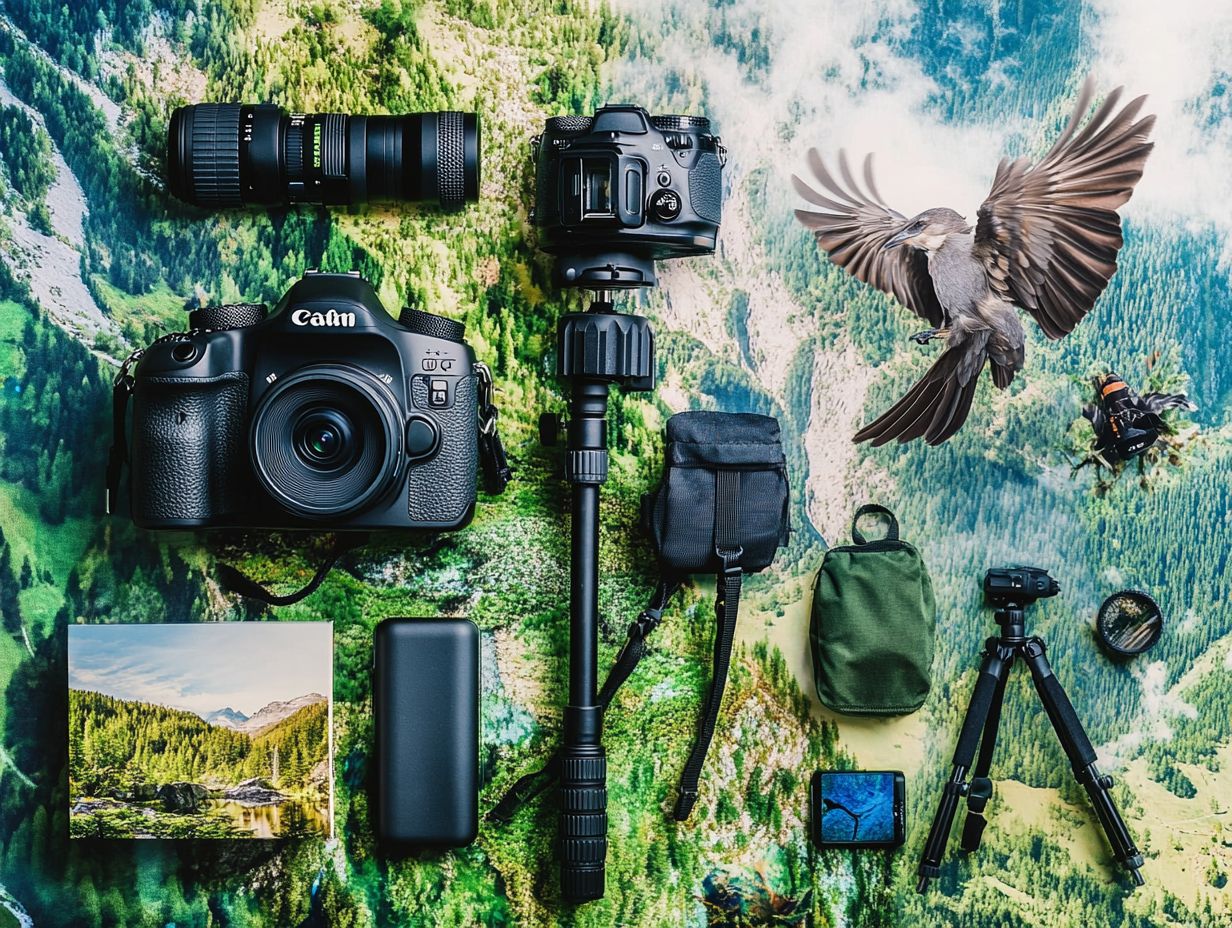
The best time for you to indulge in summer bird photography is during the early morning or late evening. In these magical hours, you can take full advantage of the soft lighting and the tranquil symphony of nature sounds that accompanies the lively antics of birds.
During these golden moments, the warm, diffused light creates an enchanting atmosphere, enhancing the vibrancy of colors in their feathers and resulting in stunning images.
With less harsh contrast than the glaring midday sun, your subjects will be beautifully illuminated, adding depth and richness to each photograph. Don t underestimate the impact of fluctuating weather conditions; they can dramatically transform the quality of light.
Picture the gentle glow of a sunrise after a refreshing rain or the soft haze of an overcast evening each brings its own charm. Embrace these conditions for capturing wildlife in their natural rhythm.
Being attuned to bird activity during these times is crucial. By observing their behaviors and interactions, you ll uncover valuable opportunities to capture intimate moments that truly showcase their natural beauty.
Don’t miss your chance to capture these magical moments!
Recommended Camera Settings for Summer Bird Photography
Effective summer bird photography hinges on mastering your camera settings. As a wildlife photographer, it’s crucial for you to adjust your settings to accommodate fast-moving subjects and the often-changing light conditions.
Employ specific shooting techniques to achieve optimal results. For instance, using a wide aperture of f/2.8 to f/4 helps create a soft background blur that isolates the birds from their surroundings. It also allows plenty of light to flood the camera, showcasing those vibrant summer hues.
A faster shutter speed, like 1/1000th of a second, is essential for freezing the action. This ensures that those rapid wingbeats are captured with clarity.
Setting your ISO around 400 can strike the perfect balance between clarity and minimal noise, accommodating the bright yet variable summer sunlight. Don t hesitate to experiment with these settings; each shoot presents unique challenges that can lead to unexpectedly stunning imagery of the captivating behaviors of birds.
How to Photograph Birds in Flight During Summer
Photographing birds in flight during summer can be an exhilarating experience. It prompts the need to master specific shooting techniques while using essential camera gear, such as a telephoto lens, to capture the beauty and grace of these avian subjects in motion.
One key technique is using continuous shooting mode. This allows you to take rapid snaps as the birds flit through the air, ensuring you won t miss that perfect moment of action.
Adjust your autofocus settings to be quick and responsive. This enables you to lock onto moving subjects with remarkable speed. Consider using brands such as Canon or Olympus for reliable performance.
Understanding the flight patterns of different species can significantly enhance your chances of nailing that stunning shot. Incorporate background scenes into your composition to add context and elevate the overall aesthetic of your photograph.
3. Fall
Fall is an exquisite season for wildlife photography. The vibrant tapestry of autumn foliage creates a breathtaking backdrop for your adventures in capturing the enchanting behaviors of birds and other creatures preparing for migration.
This seasonal shift offers exciting opportunities to see remarkable changes in avian activity. Many species become increasingly dynamic as they forage and stage for their impending journeys.
With the brilliant oranges, reds, and yellows framing their movements, capturing these moments transforms into a mesmerizing interplay of color and life. Don t miss the chance to capture these breathtaking moments before they take flight!
Consider visiting national parks, wetlands, and coastal regions during autumn, where migratory birds gather in impressive numbers. To elevate your compositions, blend the warm hues of the landscape with wildlife elements.
Think of silhouetting birds against that vibrant backdrop or using the natural reflections in tranquil pools of water. Such techniques infuse your photographs with depth and dimension, making each shot truly stunning.
How to Capture the Vibrant Colors of Fall Foliage in Bird Photography
Capturing the vibrant colors of fall foliage in bird photography demands a discerning eye and a mastery of specific techniques. This enables you to craft stunning compositions that showcase both nature’s beauty and the dynamic behavior of birds.
Start by choosing the optimal times for shooting, such as the early morning or late afternoon. During these golden hours, the soft light enhances the rich fall colors without overshadowing the scene.
Employ composition strategies like the rule of thirds or leading lines to guide the viewer s gaze toward your subject. Elegantly frame them against the stunning backdrop.
Look for contrasting colors, like a bird s bright plumage set against the deep reds and oranges of autumn leaves. This will elevate your images to truly eye-catching levels.
Experimenting with depth of field by using a wide aperture can create a beautiful blur in the background. This allows the vivid colors to pop and draws attention to your avian subjects.
Grab your camera and start capturing the beauty of summer and fall birds today!
Equipment and Techniques for Photographing Migrating Birds in Fall
To effectively photograph migrating birds in the fall, you need to combine specific photography equipment with techniques tailored to the unique behavior of birds during this migratory period.
This often means investing in a high-quality telephoto lens, which helps you take clear pictures of distant subjects, alongside a sturdy tripod to stabilize your camera against those brisk autumn winds. Be prepared to adjust your focus and exposure settings frequently, as the shifting light conditions can present various challenges.
Fast-moving birds demand quick reflexes and a keen eye for detail, so practicing techniques like continuous shooting mode and tracking autofocus is essential.
By embracing these tools and methods, you’ll be well-equipped to capture stunning images of avian life against the breathtaking backdrop of fall colors.
Challenges of Fall Bird Photography
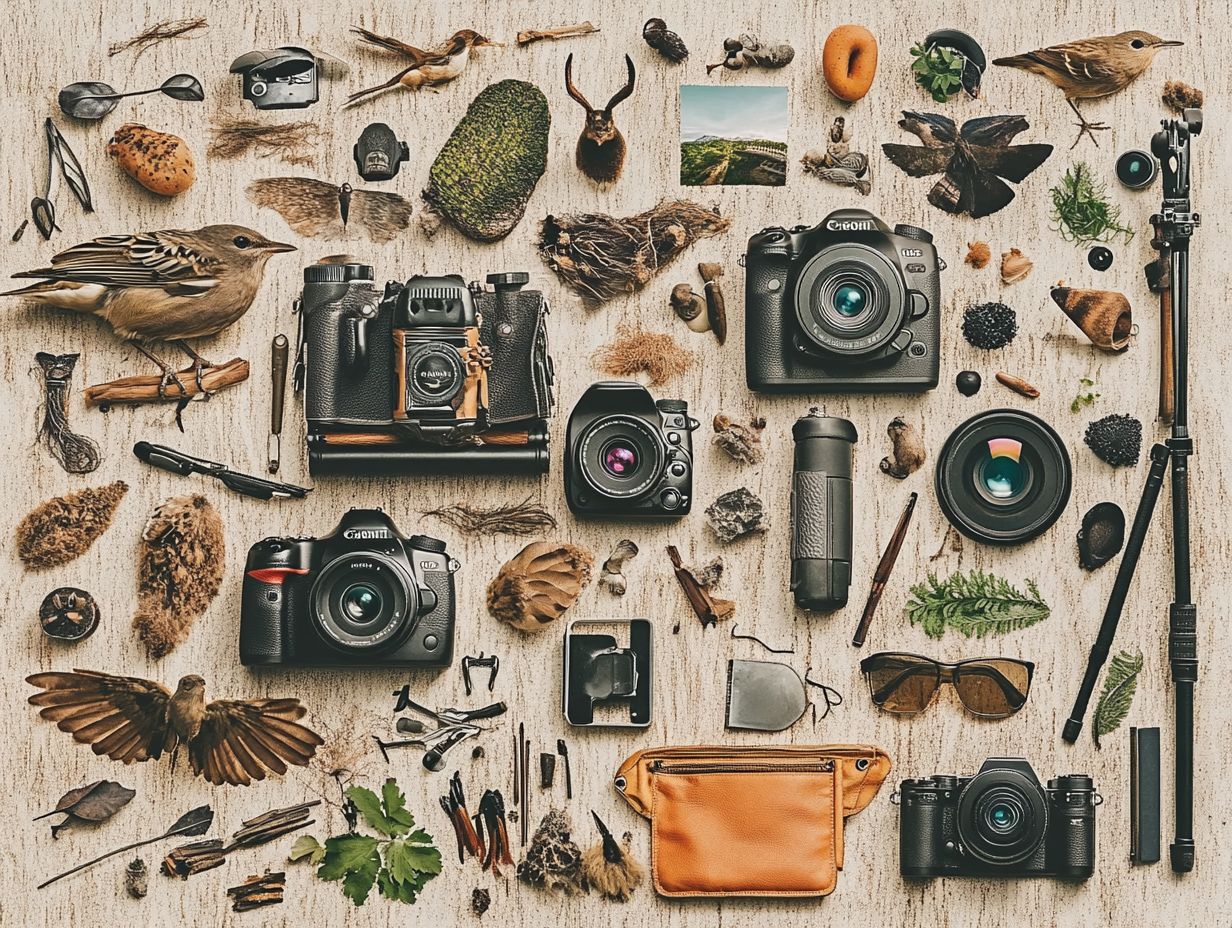
Fall bird photography presents a unique set of challenges that you, as a wildlife photographer, must navigate. Fluctuating weather conditions and varying bird behaviors require you to adhere to effective photography guidelines, as well as to consider navigating bird watching gear options for all seasons to successfully capture stunning wildlife images.
This season often surprises you with unexpected rain showers, gusty winds, and shifting temperatures, all of which can significantly influence both the behavior of birds and the quality of your photographs. Understanding the impact of weather on bird photography is crucial, especially with many species embarking on their migratory journeys, making their routines unpredictable; thus, adaptability becomes essential.
Stay alert to local weather forecasts to seize opportunities quickly and be prepared to adjust your plans at a moment s notice. Employing protective gear for both your equipment and yourself like waterproof covers and insulated clothing can enhance your comfort and safety during shoots.
Regularly observing natural habitats will deepen your understanding of migration patterns, ultimately increasing your chances of capturing breathtaking, high-quality images of birds against the backdrop of vibrant fall foliage.
4. Winter
Winter presents an exciting yet challenging backdrop for your wildlife photography adventures. As you embark on these trips, selecting the right gear for birding in winter is crucial for capturing the beauty of birds against snowy landscapes, requiring a unique approach and a keen understanding of wildlife behavior during the colder months.
Equipping yourself with specialized gear that can withstand frigid temperatures is crucial. You’ll need to ensure that your cameras and lenses are well-protected from the biting cold and moisture to keep them functioning at their best.
You will search for active birds in various locations, from frozen lakes to densely wooded areas, where wildlife forages for sustenance. Embrace patience; the perfect shot is waiting for you, sometimes requiring hours of waiting and observing.
Timing also plays an essential role. By understanding the daily patterns of bird activity, you ll enhance your chances of capturing compelling images that tell the poignant story of survival in the stark winter landscape.
How to Photograph Birds in Snowy Landscapes
Photographing birds against a snowy landscape can yield stunning images, but it demands that you refine your photography techniques to tackle the challenges posed by bright, reflective snow and the unique behaviors of birds in winter.
To effectively manage the brightness of the snow, it’s essential to adjust your exposure settings. Typically, this means reducing exposure compensation to prevent overexposing your images. This fine-tuning allows you to capture the intricate details of the birds’ plumage without losing those delicate features.
The choice of background plays a vital role in enhancing your composition; incorporating natural elements like trees, shrubs, or even colorful structures can make the birds pop against the overwhelmingly white canvas. By utilizing leading lines, interesting angles, and incorporating the winter context, you can frame your subjects beautifully and create an emotive portrayal of birds thriving in their snowy habitat.
Get ready to capture stunning moments this fall your adventure awaits!
Recommended Gear for Winter Bird Photography
When it comes to winter bird photography, selecting the right equipment is crucial. Consider exploring photography gear essentials for birdwatching and invest in weather-sealed cameras to brave the elements and capture stunning winter scenes!
You need gear that can withstand freezing temperatures while meeting the specific demands of outdoor photography. Consider using weather-sealed lenses for added protection against snow and moisture. This ensures that your vital components stay fully operational.
Look into insulated camera bags for an added layer of protection. Remember to keep your camera batteries warm; the cold can significantly shorten their lifespan. Use hand warmers or keep spare batteries close to your body to maintain their performance during those chilly shoots.
Don’t underestimate the importance of layering your clothing. Combining thermal base layers with insulated outerwear will keep you warm. This also allows for ease of movement while capturing breathtaking images of your avian subjects.
Tips for Photographing Birds in Low Light Conditions During Winter
Shooting in low light conditions during winter can be particularly challenging for wildlife photographers. However, with the right techniques and by preparing for a bird photography outing, you can capture stunning images of birds even in dim settings.
To navigate these tricky environments, consider changing your camera’s ISO settings. This allows for quicker shutter speeds while minimizing noise, creating an essential balance.
Using fast lenses with wide apertures helps you gather more light, increasing the potential for sharp details in your images. Incorporating stabilization techniques, such as using a tripod or leveraging image stabilization features, can help counteract camera shake.
This ensures clearer images, even in less-than-ideal lighting. When you combine these methods, you’ll notice a remarkable difference in producing breathtaking wildlife photography in low light.
Challenges of Winter Bird Photography and How to Overcome Them
Winter bird photography presents distinct challenges that can test even the most seasoned wildlife photographers. Harsh weather conditions and limited light require you to skillfully navigate these hurdles, making it essential to learn how to spot birds during different seasons to capture the beauty of wildlife.
Freezing temperatures can discourage even the most resilient birds from showing themselves. To maximize your chances of a rewarding shoot, schedule your outings during the warmer parts of the day when birds tend to be more active.
Familiarizing yourself with hotspots where various species gather can significantly enhance your likelihood of spotting them. By using the right camera settings like adjusting for low light and employing stabilization techniques you can produce sharper images, turning daunting challenges into opportunities for breathtaking winter photography.
Frequently Asked Questions
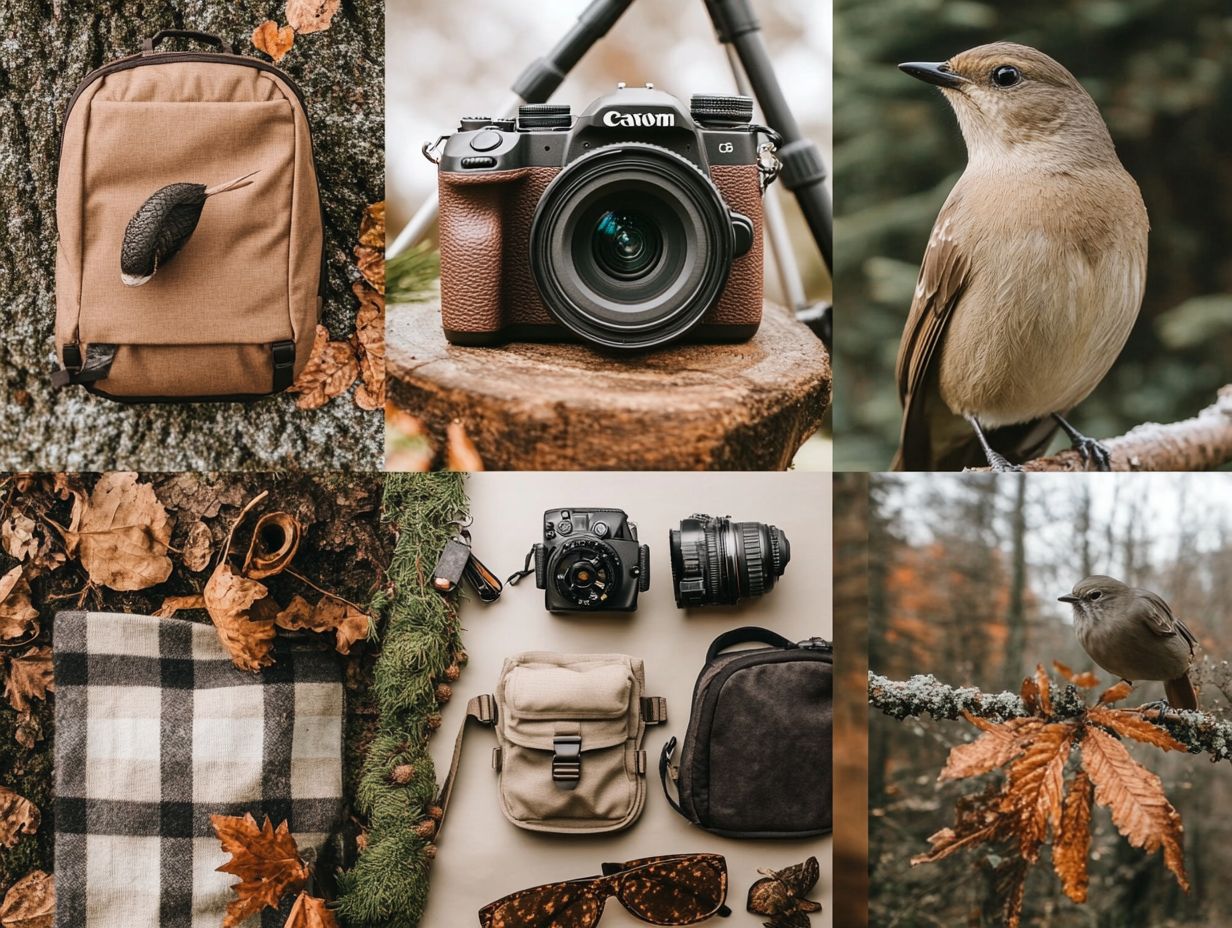
What are the essential equipment for bird photography in different seasons?
Essential equipment for bird photography includes a DSLR or mirrorless camera, a telephoto lens, a tripod, a remote shutter release, and protective gear such as a rain cover for your camera.
How can I prepare for bird photography in the winter season?
To prepare for bird photography in winter, dress in warm and waterproof layers. Bring hand warmers to keep your hands warm and use a lens hood to protect your camera lens from snow and moisture. Don’t forget to consider the must-have accessories for bird photography to enhance your experience.
What are some tips for bird photography in the spring season?
In spring, you can capture beautiful images of birds in their breeding plumage. Some tips for bird photography include using a fast shutter speed to freeze movement, focusing on the eyes of the bird, and choosing a low angle for more dynamic shots. Additionally, consider these tips for photographing birds in bad weather to enhance your photography experience.
What are the challenges of bird photography in the summer season?
The summer season presents challenges due to harsh sunlight and heat. To overcome these, try shooting during the golden hour when the light is softer, use a polarizing filter to reduce glare, and bring plenty of water to stay hydrated.
What are some techniques for bird photography in the fall season?
Capture breathtaking images that showcase vibrant fall colors! In the autumn, birds stand out beautifully against the stunning foliage.
Try using a larger opening in the camera lens to blur the background. This technique helps your subject pop in the frame.
Look for birds in motion to create lively shots. A tripod will also help you stay steady for those perfect captures.
How can I find the best locations for bird photography in different seasons?
Start by researching bird behavior in your local area. Observing where and when birds are active can lead you to the best spots.
Join local birding groups or workshops. These communities are great for discovering popular locations and sharing tips with seasoned photographers!


